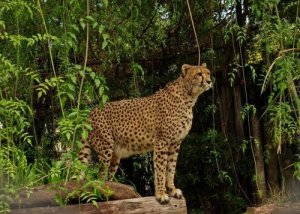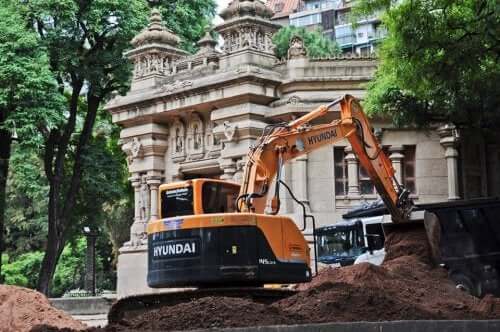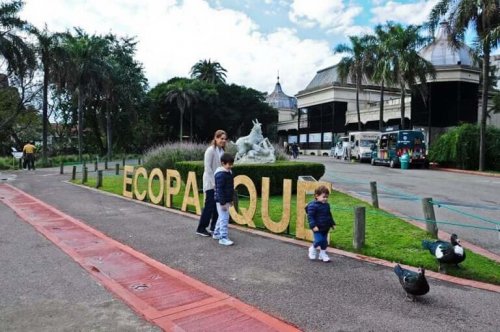Welcome to the New Buenos Aires Eco-Park

“Nothing is lost, nothing is created, everything is transformed,” said Lavoisier in 1774. It sort of sums up how the Buenos Aires zoo became an eco-park – a contribution in light of the increasing demands for animal rights and respect for the environment. This seems to be why Argentina’s capital joined the efforts of other cities around the world.
An effort to improve animal quality of life in the Buenos Aires zoo
The inauguration of this zoo took place in 1875 in the Palermo neighborhood. It soon became a popular place for locals and tourists who were eager to contemplate exotic animals.
The place evolved throughout the years and is now a far cry from the old cages where feline specimens and other species of animals spent their days locked up. It became an area where planners tried to recreate the natural habitat of the specimens on display, for the most part.
However, like most golden cages, the sad reality is the animals were in a sort of jail. They lacked freedom and independence. Many of them had to endure rather different living conditions from these of their places of origin. That was the unfortunate case of a polar bear who died in 2012 in the middle of a hot Buenos Aires summer.
In addition, we must also point out that it was a quiet place away from the heart of the city upon its creation but then ended up in the middle of the crazy transit of this large city. The noise was most definitely a problem for some animals.
Goodbye Buenos Aires zoo, hello eco-park

Finally, the Buenos Aires Zoo closed its doors in September 2017. But, it reopened a couple of years later as the Buenos Aires eco-park. The first of the three planned stages for the work took 24 months to complete.
There are about 1300 animals but the number went down to around 300. They relocated many of them to more convenient places. For instance, they transferred an elephant to a sanctuary in Mato Grosso. And, about 130 deer and antelopes went to the wild animal breeding station in La Plata, capital of the province of Buenos Aires.
The residents who remained in the former zoo did so due to either age or health reasons and couldn’t move. But the goal was to significantly improve their quality of life. Also, the goal was for native species to reside in the eco-park, always keeping rescue, rehabilitation, and breeding in mind. Also, it now has a more educational role as opposed to a recreational one.
The good news for animals in captivity was that Buenos Aires zoo completed its irreversible path to becoming an eco-park.
A green area in the middle of a big city

Similarly, building modifications happened, making sure not to alter things for the animals. In any case, the future complex kept the 52 buildings because they’re part of the Historical Heritage of the city.
The outskirts of the park became a part of the 12 hectares of free access they now have. Also, they increased their green space by 24% and reduced concrete paths by 40%.
Within the first stage, there was infrastructure work done specifically to safeguard all the species that now inhabit the eco park. For example, there’s now a veterinary hospital and a nutrition section.
The brand-new Buenos Aires eco-park
Many people thought the place would remain open to the public while its transformation took place, but, in the end, it closed. The first stage was completed in September 2019. So, it re-opened as an interactive eco-park, not only improving animals’ standards of living but also offering visitors a more educational and fulfilling experience for every member of the family.
The new park has no animals in captivity. It does house animals in need of medical care, including the ones left from the former zoo. Mainly because they weren’t strong enough for re-entry into their former habitats.
Specialists keep some animals on-site to help prepare them for re-insertion into the wild. So, in order to better protect the wildlife there, the park opens fewer hours than the zoo. This is about 2,000 visitors per day. Also, the rules strongly discourage any feeding of the animals.
The work is still ongoing but visitors can be part of its transformation process.
“Nothing is lost, nothing is created, everything is transformed,” said Lavoisier in 1774. It sort of sums up how the Buenos Aires zoo became an eco-park – a contribution in light of the increasing demands for animal rights and respect for the environment. This seems to be why Argentina’s capital joined the efforts of other cities around the world.
An effort to improve animal quality of life in the Buenos Aires zoo
The inauguration of this zoo took place in 1875 in the Palermo neighborhood. It soon became a popular place for locals and tourists who were eager to contemplate exotic animals.
The place evolved throughout the years and is now a far cry from the old cages where feline specimens and other species of animals spent their days locked up. It became an area where planners tried to recreate the natural habitat of the specimens on display, for the most part.
However, like most golden cages, the sad reality is the animals were in a sort of jail. They lacked freedom and independence. Many of them had to endure rather different living conditions from these of their places of origin. That was the unfortunate case of a polar bear who died in 2012 in the middle of a hot Buenos Aires summer.
In addition, we must also point out that it was a quiet place away from the heart of the city upon its creation but then ended up in the middle of the crazy transit of this large city. The noise was most definitely a problem for some animals.
Goodbye Buenos Aires zoo, hello eco-park

Finally, the Buenos Aires Zoo closed its doors in September 2017. But, it reopened a couple of years later as the Buenos Aires eco-park. The first of the three planned stages for the work took 24 months to complete.
There are about 1300 animals but the number went down to around 300. They relocated many of them to more convenient places. For instance, they transferred an elephant to a sanctuary in Mato Grosso. And, about 130 deer and antelopes went to the wild animal breeding station in La Plata, capital of the province of Buenos Aires.
The residents who remained in the former zoo did so due to either age or health reasons and couldn’t move. But the goal was to significantly improve their quality of life. Also, the goal was for native species to reside in the eco-park, always keeping rescue, rehabilitation, and breeding in mind. Also, it now has a more educational role as opposed to a recreational one.
The good news for animals in captivity was that Buenos Aires zoo completed its irreversible path to becoming an eco-park.
A green area in the middle of a big city

Similarly, building modifications happened, making sure not to alter things for the animals. In any case, the future complex kept the 52 buildings because they’re part of the Historical Heritage of the city.
The outskirts of the park became a part of the 12 hectares of free access they now have. Also, they increased their green space by 24% and reduced concrete paths by 40%.
Within the first stage, there was infrastructure work done specifically to safeguard all the species that now inhabit the eco park. For example, there’s now a veterinary hospital and a nutrition section.
The brand-new Buenos Aires eco-park
Many people thought the place would remain open to the public while its transformation took place, but, in the end, it closed. The first stage was completed in September 2019. So, it re-opened as an interactive eco-park, not only improving animals’ standards of living but also offering visitors a more educational and fulfilling experience for every member of the family.
The new park has no animals in captivity. It does house animals in need of medical care, including the ones left from the former zoo. Mainly because they weren’t strong enough for re-entry into their former habitats.
Specialists keep some animals on-site to help prepare them for re-insertion into the wild. So, in order to better protect the wildlife there, the park opens fewer hours than the zoo. This is about 2,000 visitors per day. Also, the rules strongly discourage any feeding of the animals.
The work is still ongoing but visitors can be part of its transformation process.
This text is provided for informational purposes only and does not replace consultation with a professional. If in doubt, consult your specialist.








